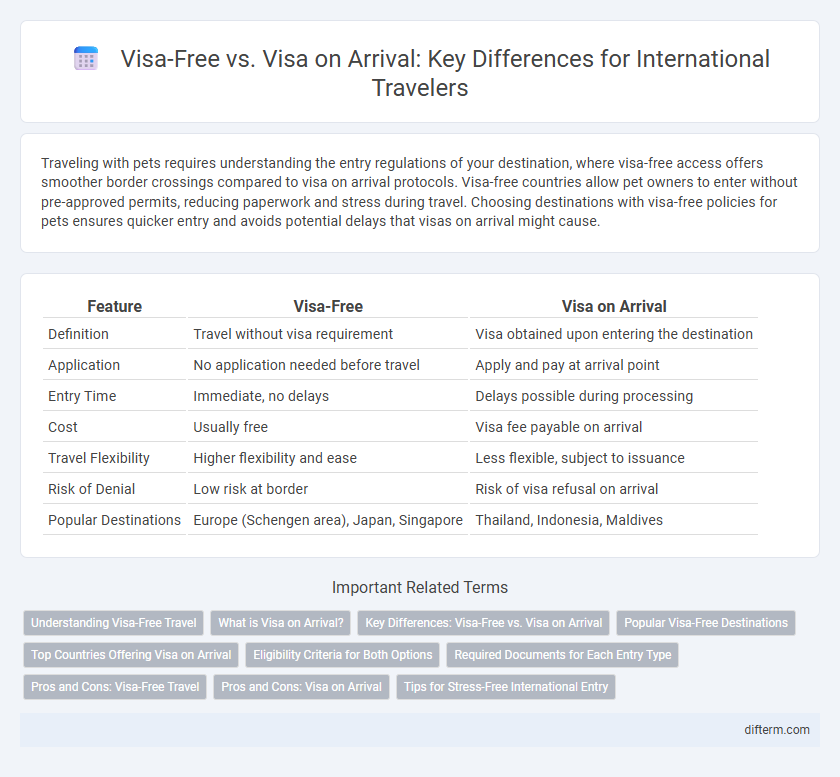Traveling with pets requires understanding the entry regulations of your destination, where visa-free access offers smoother border crossings compared to visa on arrival protocols. Visa-free countries allow pet owners to enter without pre-approved permits, reducing paperwork and stress during travel. Choosing destinations with visa-free policies for pets ensures quicker entry and avoids potential delays that visas on arrival might cause.
Table of Comparison
| Feature | Visa-Free | Visa on Arrival |
|---|---|---|
| Definition | Travel without visa requirement | Visa obtained upon entering the destination |
| Application | No application needed before travel | Apply and pay at arrival point |
| Entry Time | Immediate, no delays | Delays possible during processing |
| Cost | Usually free | Visa fee payable on arrival |
| Travel Flexibility | Higher flexibility and ease | Less flexible, subject to issuance |
| Risk of Denial | Low risk at border | Risk of visa refusal on arrival |
| Popular Destinations | Europe (Schengen area), Japan, Singapore | Thailand, Indonesia, Maldives |
Understanding Visa-Free Travel
Visa-free travel allows travelers to enter a destination country without obtaining a visa beforehand, enabling seamless entry for short stays typically ranging from 30 to 90 days. This simplifies international travel by eliminating the need for pre-departure paperwork, reducing wait times and expenses associated with visa applications. Countries offering visa-free access often establish strong diplomatic relations and reciprocal agreements, making visa-free travel a key factor in enhancing tourism and business opportunities.
What is Visa on Arrival?
Visa on Arrival allows travelers to obtain a visa upon entering the destination country, eliminating the need to apply beforehand. This type of visa is typically issued at designated entry points such as airports or land borders and may require travelers to pay a fee and provide certain documents like a return ticket or hotel reservation. Visa-free entry, in contrast, permits visitors to enter the country without any visa requirement, simplifying travel but usually for a limited duration.
Key Differences: Visa-Free vs. Visa on Arrival
Visa-free entry allows travelers to enter a country without obtaining a visa beforehand or upon arrival, often for short stays up to 90 days, enhancing convenience and reducing pre-trip preparation. Visa on arrival requires securing a visa at the port of entry, which may involve filling out forms, paying fees, and waiting in queues, making the process slightly more time-consuming. Understanding the specific country's policies and eligibility criteria for each visa type is crucial for seamless international travel planning.
Popular Visa-Free Destinations
Popular visa-free destinations such as Japan, Brazil, and Turkey offer travelers hassle-free entry, eliminating the need for advance visas and allowing extended stays ranging from 30 to 90 days. These countries attract millions annually due to their diverse attractions and lenient visa policies that enhance spontaneous travel plans. Visa-free access typically expedites airport immigration processes, improving overall trip convenience compared to visa-on-arrival destinations where travelers may face longer wait times and additional fees.
Top Countries Offering Visa on Arrival
Top countries offering visa on arrival include Thailand, Indonesia, Sri Lanka, and Kenya, providing travelers with convenient entry without prior visa applications. This option allows short-term visitors to obtain their visa directly at the airport or border crossing, streamlining the travel process. Visa on arrival policies often cater to tourists seeking flexible, last-minute trips, enhancing accessibility to popular destinations.
Eligibility Criteria for Both Options
Visa-free entry allows travelers to enter a country without obtaining a visa beforehand, primarily based on their nationality and bilateral agreements, typically requiring a valid passport with a minimum remaining validity period of six months. Visa on arrival eligibility depends on travelers holding a passport from an approved country, often accompanied by specific documentation such as return tickets, proof of accommodation, and sufficient funds for the visit. Both options streamline border crossing but differ in application processes and conditional requirements set by the destination country's immigration policies.
Required Documents for Each Entry Type
Visa-free travel allows entry without prior documentation beyond a valid passport, simplifying border crossing with minimal paperwork. Visa on arrival requires travelers to prepare specific documents such as return tickets, proof of accommodation, and sometimes a completed visa application form or passport photos before landing. Both entry types demand compliance with national regulations, but visa on arrival usually entails more rigorous document verification at the point of entry.
Pros and Cons: Visa-Free Travel
Visa-free travel allows travelers to enter a country without obtaining a visa in advance, significantly reducing time and paperwork. This convenience enhances spontaneous travel and lowers costs by eliminating visa fees and processing delays. However, visa-free entry often comes with shorter authorized stays and limited access to work or study, restricting long-term or multifaceted visits.
Pros and Cons: Visa on Arrival
Visa on arrival offers travelers convenience by allowing entry without prior application, reducing planning time and paperwork. However, it can lead to longer waiting times at immigration checkpoints and carries the risk of denial upon arrival, which may disrupt travel plans. Costs for visa on arrival may also be higher or vary compared to pre-obtained visas, impacting budget predictability.
Tips for Stress-Free International Entry
For stress-free international entry, understanding the difference between visa-free and visa-on-arrival policies is crucial. Travelers should research destination-specific requirements, ensuring all necessary documents, such as return tickets and sufficient funds, are prepared in advance. Keeping copies of identification and monitoring entry regulations through official government or embassy websites can prevent unexpected delays and streamline border crossings.
Visa-free vs Visa on arrival Infographic

 difterm.com
difterm.com